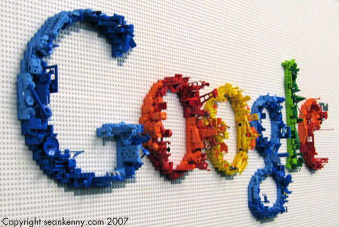May 9, 2008
Googlevision: Part I
 It’s difficult to talk about the future of media (at least, as I see it) without talking about Google. And yet a lot of people remain in the dark about just what Google does, or what it’s trying to do. Hopefully I can explain why I think Google is the most important company of the 21st century (at least when it comes to communications), and I also hope I’m right. Time will tell!
It’s difficult to talk about the future of media (at least, as I see it) without talking about Google. And yet a lot of people remain in the dark about just what Google does, or what it’s trying to do. Hopefully I can explain why I think Google is the most important company of the 21st century (at least when it comes to communications), and I also hope I’m right. Time will tell!
You may have read last month that Google’s profit jumped 30% last quarter in spite of the sluggish economy. But where exactly does Google’s profit come from? How do you earn $1.31 billion in three months by offering people free online services? True, their search engine and maps application are the best available, but how does that translate into money for Google?
Google’s primary function is not as a search engine, but as an advertising aggregator. Basically, this means that Google collects and places advertising online – ads that may generate revenue in mere fractions of cents individually, but number in the billions. It’s nowhere near as profitable as the advertising revenue generated by television, but as television as we know it continues to evolve, that will all change.
I’m oversimplifying a little; Wikipedia describes Google’s revenue streams as “online and mobile advertising related to its Internet search, web-based e-mail, online mapping, office productivity, social networking, and video sharing as well as selling advertising-free versions of the same technologies.” As you can see, they have their fingers in a lot of pies, but all of it relates to how we use technology to manage information and mediate communication in our lives. Google essentially is the mediator, inserting itself between the user and the information they want, then bringing them together, and dropping advertising into the process. The more information they mediate, the more advertising revenue they can generate.
A bit about advertising: there are essentially two ways of looking at advertising as an economic model. The first model – the one advertisers would like you to favour – is sometimes described as a “gift” economy: basically, the generous people who make your favourite TV shows or community newspapers or websites provide the content to you free of charge – a gift! In return, all they ask is that you endure a little advertising. The other model views the transaction from the opposite perspective: content is just a lure to attract viewers, who are then delivered to advertisers. Content providers earn their revenue by providing sets of eyes for advertisers (who in turn profit by taking money for the service of spreading messages). If content doesn’t deliver viewers to advertisers, it’s useless to them.
Of course, Long Tail theory applies here; on a crowded TV dial, programming has to attract viewers or it gets cancelled and replaced by something people want to watch (at least, that’s the idea). A website that gets very few hits, however, can carry exactly as much advertising as it needs; it may not make the webmaster very much money, but since it costs next to nothing to maintain, and there’s unlimited room for as many websites as people care to make, and each website can have advertising customised to as many or as few hits as it gets, competitiveness isn’t really a factor in whether a website can justify its existence. A website that gets one hit a day, and gets a tenth of a cent per hit may not generate profit for the people who manage the website, but if the advertising is supplied by Google, Google also gets a tenth of a cent – multiply this by a few billion websites and you start making real money.
The gift economy applies as much to the Internet as it does to TV. It’s not as profitable yet, because people use the Internet and TV in different ways, and in different numbers. But when you consider that the amount of content on TV is finite, and the amount of content on the Internet (or Email, or social networks, or wireless applications, and so on) is infinite, you start to see that all that content is a huge goldmine, if someone can just figure out how to embed advertising in an effective way.
That’s where Google comes in.
[Jump to Part II]

I should come clean: I’m shamelessly pro-Google. I think they’re generally more concerned about the user experience than any of the other media conglomerates out there. They’re also much more supportive of openness. This is probably because, unlike, say, Time Warner or The Walt Disney Corporation, Google doesn’t produce any content (unless you consider a map content; this is hardly on the same level as dozens of TV channels with hundreds of shows, scores of magazines and so on). For this reason, protecting content isn’t nearly as important to Google as delivering it is. This model is very consumer-oriented and, frankly, empowers the audience. There will be more on this later.
Secondly, I want to give proper credit for my description of the “gift” economy. This was not my original idea, of course, but rather one described in “Channels of Discourse, Reassembled” a TV studies textbook. You can get info this book here:
http://www.amazon.com/Channels-Discourse-Reassembled-Television-Contemporary/dp/0415080592/ref=pd_bbs_1?ie=UTF8&s=books&qid=1210381895&sr=8-1